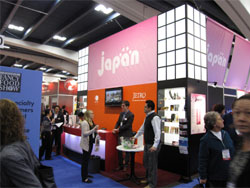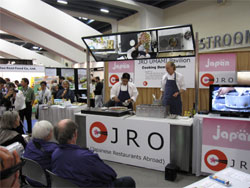Reports and Statistics
The Key: Japanese Cuisine to Suit American Tastes- Winter Fancy Food Show (U.S.A.) -
Feb 22, 2012
JETRO presented the Japan Pavilion, for the first time, at the Winter Fancy Food Show, the annual specialty food and beverage event, which was held in San Francisco from January 15 to 17. Companies impacted by the March 11, 2011, earthquake enthusiastically exhibited, wanting "to help revitalize our region." In a sign of the great popularity of foods from Japan, the Japan Pavilion attracted even more attention than the other national pavilions. The exhibitors, engaging in business talks with many buyers who visited the Japan Pavilion, gained a better grasp of the potential for overseas business development and of the issues to be resolved.
The first Japan Pavilion
The Fancy Food Show, the largest food and beverage trade fair in the United States, is usually held twice a year, on the East Coast in summer and on the West Coast in winter. This year's winter show, the thirty-seventh to be held on the west coast, was in San Francisco's Moscone Center. In addition to American companies in the food and beverage industry, the show featured a series of international pavilions, including the Italian and Canadian pavilions, and attracted about 1,300 participating companies from over 35 countries. The show was packed with buyers from restaurants, retail stores, and other food-related businesses in search of new products. (The 2011 show, for example, attracted over 17,000 visitors.)
JETRO organized a Japan Pavilion for the first time and provided the exhibitors, 26 companies and two organizations selected from a nationwide applicant pool, support in conducting business talks. The exhibiting companies were in a wide range of fields, including alcoholic and other beverages, sauces and dressings, baked goods and confectionary, processed vegetables, and seafood. They included companies that already have manufacturing bases in the United States as well as others gearing up to enter the U.S. market for the first time.
The companies tackling what is for them a new market positioned this show as a first step in exploring the U.S. market's potential; while observing the response on the West Coast, they will also consider moving into the East Coast. Companies that already have manufacturing bases in the U.S. utilized the show as a public relations opportunity, to boost their name recognition. Companies from Fukushima, which was hard hit by the March 11 disaster, spoke of their desire, by daring to set their sights on overseas opportunities, to restore liveliness and vigor to their region, where an atmosphere of self-imposed restraint still prevails.

The food and beverage market: large scale and small risk are pluses
We asked exhibitors what they saw as the attraction of the U.S. food and beverage market. The first point they mentioned was the sheer size of the market. Companies that exhibit in many of the food and beverage shows held all over the world said that, to them, the large size of lots for original equipment manufacturing (OEM) of products for the U.S. market reconfirms the large U.S. market scale.
The second draw they mentioned is the American business environment. Several companies that already have a track record in exporting to Asian countries commented that “The hurdles we have to surmount in order to enter the U.S. market are high, but, compared with much of Asia, it has a well organized business environment.” “The United States is a litigious society and a contract society. In other words, the risk of having a business contract violated is small.” They appreciate the low risk concerning, for instance, recovering accounts receivable.
During the show, exhibitors had highly positive contact with visitors through which they were able to discover issues to be addressed and valuable information for developing their operations in the future. A company that deals in health foods, for example, had chosen to participate in view of the health boom in the United States. The many detailed questions about health-related matters its participants in the show received from visitors gave them a greater sense of the vigor of health-oriented interests there. They also noted, however, that while they perceived considerable interest in their products, price was going to be an issue in actually closing a deal.
An exhibitor who handles sauces and dressings reported that while miso soup, which is made with miso , or fermented soybean paste, has high name recognition in the U.S., they were astonished at the large number of Americans who did not know that miso soup is in fact made with a stock typically based on katsuo bushi , sliced dried bonito. The takeaway was that while awareness of Japanese cuisine is high, it remains superficial; an understanding of the fundamentals has yet to come. Another company in the same field, however, reported a strong response when it presented its products in a Western context, while emphasizing the health benefits of miso and that it has been used as a flavoring ingredient in Japan from time immemorial. Their experience confirmed anew the importance of presenting products in ways that suit local preferences.
Visitors to the Japan Pavilion reported great satisfaction with the experience, commenting that they had a chance to encounter Japanese foods and ingredients they hadn’t known about before and to learn much more about ingredients they had thought they were familiar with. The pavilions of countries that are Japanese cuisine’s rival among the world’s cuisines, including Italy and France, were ranked nearby, but the Japan Pavilion attracted a conspicuously larger number of visitors.
Cooking demonstrations deepen understanding of Japanese ingredients

In addition to presenting the Japan Pavilion, JETRO also organized cooking demonstrations in collaboration with the Organization to Promote Japanese Restaurants Abroad (JRO). The concept was to propose innovative culinary ideas based on Japanese ingredients. Using Japanese ingredients offered by the companies exhibiting in the Japan pavilion, famous local chefs and bartenders served up a feast devised to suit American palates, from risotto made with miso to cocktails made with sake . After each demonstration, the exhibitors who provided the ingredients climbed on stage for question-and-answer sessions that provided good PR opportunities for their products.
In all, nine cooking demonstrations were carried out during the three days of the show. During them, the fifteen or so chairs set up in front of the stage proved to be far too few, as crowds of people gathered around. Those who sampled what the chefs and bartenders created shared their impressions with us. One said, "I thought miso was just something used to make miso soup. It's news to me that it can also be used as a seasoning." Another noted, "I sometimes drink sake, but put it in a cocktail and I think there'd be more opportunities to drink it." The chefs and bartenders who carried out the demonstrations, for their part, said that it had been quite stimulating to tackle new territory in preparation for the demonstrations and that they had gained a deeper understanding of Japanese ingredients in the process. All in all, the cooking demonstrations helped create a deeper appreciation of a variety of Japanese ingredients, among both the chefs and the visitors, and gave a good sense of the potential for the further spread of Japanese cuisine.
Yasuda Takehiko of the JRO, who coordinated the cooking demonstrations, observed, “The new dishes created in line with our concept might, strictly speaking, diverge from Japanese tradition, but I think it’s important to come up with things that suit the tastes of people in the country we are trying to reach. Italian cuisine has spread far and wide in Japan, but it’s a version of Italian cuisine that is very accessible to Japanese people. By creating Japanese dishes that suit Americans, we will help Japanese cuisine put down deep roots throughout American, and that will lead to an expansion of exports, won’t it?”
Yasuda, who has been involved in the food industry in the United States for many years, was on the spot to experience for himself what happened back when the avocado roll began becoming popular all around the United States thirty years ago. Looking back, he sees the avocado roll—an example of an innovative recipe that did not exist in Japan—as a big factor behind moving sushi into the major culinary leagues in the United States back then. Speaking with passion about his love of Japanese cuisine, he said he hoped that promotional events like the cooking demonstrations would stimulate an even greater spread of Japanese culture and provide the impetus for increased exports of Japanese foodstuffs.



